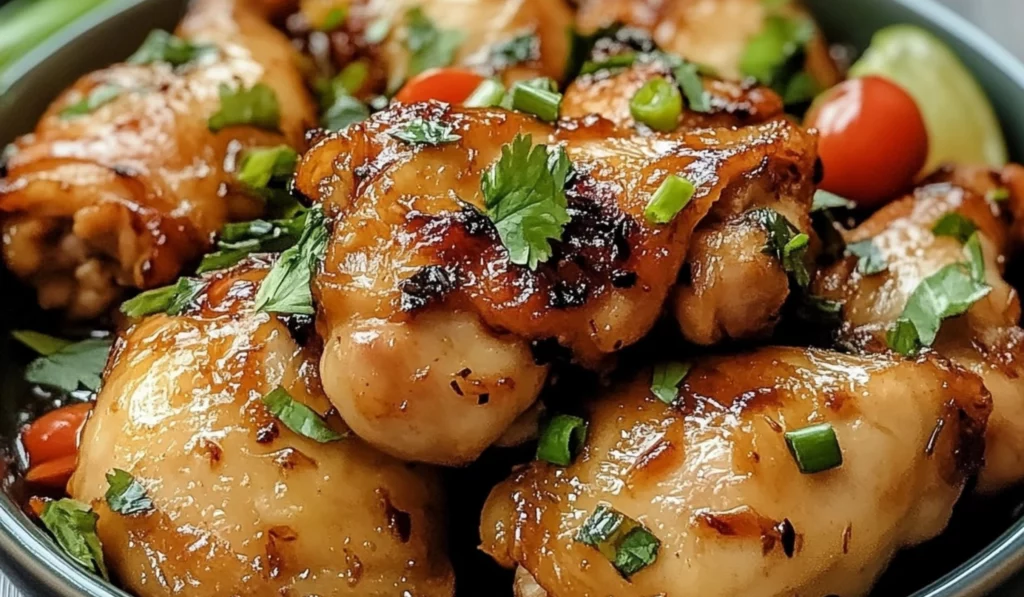I remember the first time I tried Vietnamese Lemongrass Chicken. The fragrant lemongrass, the savory fish sauce, and the subtle heat of chili flakes created a symphony of flavors that danced on my palate. It was a revelation! I was immediately hooked and determined to recreate this delicious dish at home. What surprised me most was how easy it was to make. This recipe is absolutely perfect for beginner cooks. It’s relatively quick, requires minimal cooking skills, and is a fantastic way to introduce yourself to the vibrant flavors of Vietnamese cuisine. Plus, it’s a healthier option compared to many takeout dishes. If you’re looking for an easy, flavorful, and aromatic chicken recipe, this Vietnamese Lemongrass Chicken is a must-try!

Vietnamese Lemongrass Chicken: A Beginner’s Journey to Aromatic Flavors
Craving a taste of Southeast Asia? This Vietnamese Lemongrass Chicken is the perfect dish! Fragrant lemongrass, savory fish sauce, and a touch of chili flakes create a symphony of flavors that will tantalize your taste buds. Imagine tender chicken infused with aromatic spices, served with fluffy rice and a sprinkle of fresh cilantro. It’s a feast for the senses, perfect for any weeknight. This easy recipe is ideal for beginner cooks, requiring minimal prep and delivering maximum flavor.
- Prep Time: 15 minutes
- Cook Time: 20 minutes
- Total Time: 35 minutes (plus marinating time)
- Yield: 4 servings 1x
- Category: Main Course, Dinner
- Method: Sautéing, Stir-frying
- Cuisine: Vietnamese
Ingredients
- 4 boneless, skinless chicken thighs (or breasts)
- 2 tbsp finely chopped lemongrass
- 4 cloves garlic, minced
- 2 tbsp fish sauce (or soy sauce)
- 1 tbsp brown sugar
- 1 tbsp soy sauce
- 1 tsp turmeric powder
- 1 tbsp lime juice
- 1 tsp chili flakes (optional)
- 1 tbsp vegetable oil (for marinating)
- 2 tbsp vegetable oil (for cooking)
- 1 medium onion, thinly sliced
- 1 red bell pepper, julienned (optional)
- 1 tsp sesame oil (optional)
- Fresh cilantro, chopped (for garnish)
- Lime wedges (for serving)
- Steamed white rice or jasmine rice (for serving)
Instructions
First Step: Marinate the Chicken
- Prepare the Marinade: In a medium-sized bowl, combine the finely chopped lemongrass, minced garlic, fish sauce, soy sauce, brown sugar, turmeric powder, lime juice, chili flakes (if using), and vegetable oil. Stir everything together until the sugar is dissolved and the ingredients are evenly mixed. Make sure the lemongrass is finely chopped to release its aromatic oils.
- Marinate the Chicken: Place the chicken thighs in a resealable plastic bag or shallow dish. Pour the marinade over the chicken, ensuring the pieces are well-coated. Seal the bag or cover the dish with plastic wrap. Refrigerate for at least 1 hour, or overnight for the best flavor infusion. Marinating the chicken allows the flavors to penetrate the meat, making it more flavorful and tender. The longer you marinate the chicken, the more flavorful it will become.
- (Optional Tip): For extra tenderness, you can lightly score the chicken with a knife before marinating. This will allow the flavors to penetrate deeper into the meat and help it to cook more evenly.
Second Step: Prepare the Cooking Ingredients
- Slice the Vegetables: While the chicken marinates, thinly slice the onion and julienne the red bell pepper. These vegetables will be sautéed alongside the chicken for added texture and flavor. Slicing the onion thinly will allow it to cook quickly and evenly. Julienning the bell pepper (cutting it into thin, matchstick-like strips) gives it a nice texture and makes it visually appealing.
- Prep the Garnishes: Chop fresh cilantro and prepare lime wedges for garnish and serving. Having your garnishes prepped and ready to go will make the final steps of the recipe quicker and easier.
- Heat the Cooking Oil: In a large skillet or wok, heat 2 tablespoons of vegetable oil over medium-high heat. A wok is ideal for stir-frying as it has sloped sides that allow for even cooking. If you don’t have a wok, a large skillet will work just as well. Make sure the oil is hot before adding the vegetables.
Third Step: Cook the Chicken
- Cook the Chicken: In the same skillet or wok, add a bit more oil if needed. Place the marinated chicken thighs in the pan and cook them over medium-high heat for about 4-5 minutes per side, or until the chicken is golden brown and cooked through. The internal temperature should reach 165°F (74°C). Cooking the chicken over medium-high heat will give it a nice sear and help to keep it moist. Use a meat thermometer to check the internal temperature of the chicken to ensure it is cooked through.
- (Optional Tip): If you want extra crispiness on the chicken, increase the heat slightly during the last 2 minutes of cooking, but be sure to monitor it closely to avoid burning the marinade. The sugars in the marinade can caramelize quickly at high heat, so keep a close eye on the chicken to prevent it from burning.
- Rest the Chicken: Once the chicken is cooked, remove it from the pan and let it rest for 5 minutes. This allows the juices to redistribute, ensuring the meat stays moist and flavorful. Resting the chicken is an important step that should not be skipped.
Fourth Step: Combine and Serve
- Combine Vegetables and Chicken: After the chicken has rested, slice it into strips or bite-sized pieces. Returning the chicken to the pan after it has rested and been sliced allows it to warm up slightly and also allows it to pick up any remaining sauce in the pan. Return the sautéed onions and peppers to the pan, and toss them together with the chicken. Optionally, drizzle a little sesame oil over the mixture for a deeper flavor. Sesame oil adds a nutty and aromatic flavor that complements the other ingredients.
- Garnish and Serve: Plate the chicken and vegetable mixture, and garnish with fresh cilantro. Serve with a side of steamed jasmine rice, lime wedges, and any additional sides such as fresh vegetables or a simple salad for added crunch. The fresh cilantro adds a bright and refreshing element to the dish. The lime wedges are used to squeeze fresh lime juice over the chicken, adding a final burst of citrus flavor. Steamed jasmine rice is the traditional accompaniment to Vietnamese dishes.
Notes
- Use the tender inner part of the lemongrass stalk.
- Marinate chicken for at least 1 hour for best flavor.
- Use a meat thermometer to check chicken’s doneness (165°F/74°C).
- Adjust chili flakes to your spice preference.
Ingredients and Preparation: The Building Blocks of Flavor
This recipe uses a combination of fresh and pantry-staple ingredients. Here’s a detailed list:
For the Chicken Marinade:
- Boneless, Skinless Chicken Thighs: 4 (or chicken breasts for a leaner option). Chicken thighs are used in this recipe for their juiciness and flavor, but chicken breasts can be substituted for a leaner option. Thighs will remain more moist during cooking.
- Fresh Lemongrass: 2 tablespoons, finely chopped (use the tender inner part of the stalk). Lemongrass is the star of this dish, providing a bright, citrusy, and aromatic flavor. Use only the tender inner part of the stalk, as the outer layers can be tough and fibrous.
- Garlic: 4 cloves, minced. Garlic adds a pungent and aromatic flavor. Freshly minced garlic is best.
- Fish Sauce: 2 tablespoons (or soy sauce for a vegetarian version). Fish sauce adds a savory, umami flavor that is characteristic of Vietnamese cuisine. Soy sauce can be used as a vegetarian substitute, but the flavor will be slightly different.
- Brown Sugar: 1 tablespoon. Brown sugar adds a touch of sweetness and helps to balance the savory and tangy flavors.
- Soy Sauce: 1 tablespoon. Soy sauce adds a salty and umami flavor.
- Turmeric Powder: 1 teaspoon (for color and subtle flavor). Turmeric powder adds a beautiful golden color to the chicken and a subtle earthy flavor.
- Lime Juice: 1 tablespoon, freshly squeezed. Lime juice adds a bright, citrusy, and tangy flavor. Freshly squeezed lime juice is always best.
- Chili Flakes: 1 teaspoon (optional, for a spicy kick). Chili flakes add a touch of heat. Omit if you prefer a milder flavor.
- Vegetable Oil: 1 tablespoon (for marinating). Vegetable oil helps to distribute the marinade evenly and keeps the chicken moist during marinating.
For Cooking:
- Vegetable Oil: 2 tablespoons (for cooking). Vegetable oil is used for sautéing the vegetables and cooking the chicken.
- Onion: 1 medium, thinly sliced. Onion adds flavor and texture to the dish.
- Red Bell Pepper: 1 (julienned, optional, for added crunch and color). Red bell pepper adds sweetness, color, and crunch.
- Sesame Oil: 1 teaspoon (optional, for extra depth of flavor). Sesame oil adds a nutty and aromatic flavor.
- Fresh Cilantro: Chopped (for garnish). Fresh cilantro adds a fresh and herbaceous flavor.
- Lime Wedges: (for serving). Lime wedges are served alongside the chicken for an extra burst of citrus flavor.
For Serving:
- Steamed White Rice or Jasmine Rice: Rice is the traditional accompaniment to Vietnamese dishes.
- Fresh Vegetables or a Side Salad: Adding fresh vegetables or a side salad provides a healthy and refreshing contrast to the chicken.
Alternative Ingredient Suggestions:
- Chicken: You can use chicken breasts instead of thighs for a leaner option. You can also use other cuts of chicken, such as drumsticks or wings, but cooking times may vary.
- Vegetables: Feel free to add other vegetables to the stir-fry, such as carrots, mushrooms, or snow peas.
- Flavorings: You can adjust the amount of chili flakes to your liking, or add other spices, such as ginger or coriander.
Step-by-Step Instructions: Creating Your Vietnamese Lemongrass Chicken Masterpiece
First Step: Marinate the Chicken
- Prepare the Marinade: In a medium-sized bowl, combine the finely chopped lemongrass, minced garlic, fish sauce, soy sauce, brown sugar, turmeric powder, lime juice, chili flakes (if using), and vegetable oil. Stir everything together until the sugar is dissolved and the ingredients are evenly mixed. Make sure the lemongrass is finely chopped to release its aromatic oils.
- Marinate the Chicken: Place the chicken thighs in a resealable plastic bag or shallow dish. Pour the marinade over the chicken, ensuring the pieces are well-coated. Seal the bag or cover the dish with plastic wrap. Refrigerate for at least 1 hour, or overnight for the best flavor infusion. Marinating the chicken allows the flavors to penetrate the meat, making it more flavorful and tender. The longer you marinate the chicken, the more flavorful it will become.
- (Optional Tip): For extra tenderness, you can lightly score the chicken with a knife before marinating. This will allow the flavors to penetrate deeper into the meat and help it to cook more evenly.
Second Step: Prepare the Cooking Ingredients
- Slice the Vegetables: While the chicken marinates, thinly slice the onion and julienne the red bell pepper. These vegetables will be sautéed alongside the chicken for added texture and flavor. Slicing the onion thinly will allow it to cook quickly and evenly. Julienning the bell pepper (cutting it into thin, matchstick-like strips) gives it a nice texture and makes it visually appealing.
- Prep the Garnishes: Chop fresh cilantro and prepare lime wedges for garnish and serving. Having your garnishes prepped and ready to go will make the final steps of the recipe quicker and easier.
- Heat the Cooking Oil: In a large skillet or wok, heat 2 tablespoons of vegetable oil over medium-high heat. A wok is ideal for stir-frying as it has sloped sides that allow for even cooking. If you don’t have a wok, a large skillet will work just as well. Make sure the oil is hot before adding the vegetables.
Third Step: Cook the Chicken
- Cook the Chicken: In the same skillet or wok, add a bit more oil if needed. Place the marinated chicken thighs in the pan and cook them over medium-high heat for about 4-5 minutes per side, or until the chicken is golden brown and cooked through. The internal temperature should reach 165°F (74°C). Cooking the chicken over medium-high heat will give it a nice sear and help to keep it moist. Use a meat thermometer to check the internal temperature of the chicken to ensure it is cooked through.
- (Optional Tip): If you want extra crispiness on the chicken, increase the heat slightly during the last 2 minutes of cooking, but be sure to monitor it closely to avoid burning the marinade. The sugars in the marinade can caramelize quickly at high heat, so keep a close eye on the chicken to prevent it from burning.
- Rest the Chicken: Once the chicken is cooked, remove it from the pan and let it rest for 5 minutes. This allows the juices to redistribute, ensuring the meat stays moist and flavorful. Resting the chicken is an important step that should not be skipped.
Fourth Step: Combine and Serve
- Combine Vegetables and Chicken: After the chicken has rested, slice it into strips or bite-sized pieces. Returning the chicken to the pan after it has rested and been sliced allows it to warm up slightly and also allows it to pick up any remaining sauce in the pan. Return the sautéed onions and peppers to the pan, and toss them together with the chicken. Optionally, drizzle a little sesame oil over the mixture for a deeper flavor. Sesame oil adds a nutty and aromatic flavor that complements the other ingredients.
- Garnish and Serve: Plate the chicken and vegetable mixture, and garnish with fresh cilantro. Serve with a side of steamed jasmine rice, lime wedges, and any additional sides such as fresh vegetables or a simple salad for added crunch. The fresh cilantro adds a bright and refreshing element to the dish. The lime wedges are used to squeeze fresh lime juice over the chicken, adding a final burst of citrus flavor. Steamed jasmine rice is the traditional accompaniment to Vietnamese dishes.
Beginner Tips and Notes: Mastering the Art of Flavorful Chicken
- Troubleshooting: Chicken is dry: If your chicken is dry, it is likely overcooked. Use a meat thermometer to check the internal temperature of the chicken to ensure it is cooked through but not overcooked. You can also try marinating the chicken for a longer period of time, as this will help to keep it moist.
- Troubleshooting: Marinade is too thick: If your marinade is too thick, you can add a tablespoon or two of water or chicken broth to thin it out.
- Efficient Prep: You can chop the lemongrass and garlic ahead of time and store them in the refrigerator for up to 2 days. You can also marinate the chicken ahead of time and store it in the refrigerator for up to 24 hours. This will make the cooking process much quicker and easier.
- Lemongrass Preparation: When preparing lemongrass, use only the tender inner part of the stalk. Cut off the tough outer layers and the leafy green tops. Thinly slice the remaining stalk and then finely chop it. You can also use a food processor to chop the lemongrass.
- Wok vs. Skillet: A wok is ideal for stir-frying as it has sloped sides that allow for even cooking. However, if you don’t have a wok, a large skillet will work just as well. Make sure the skillet is hot before adding the ingredients.
- Serving Suggestions: This Vietnamese Lemongrass Chicken is delicious served with steamed rice, but you can also serve it with noodles or a salad. You can also add other toppings, such as chopped peanuts or shredded carrots.
Serving Suggestions: Completing Your Vietnamese Feast
This Vietnamese Lemongrass Chicken is traditionally served with steamed rice, but it can also be served with other sides:
- Steamed Rice: Steamed white rice or jasmine rice is the perfect accompaniment to this dish.
- Noodles: Rice noodles or vermicelli noodles are also a delicious option.
- Salad: A simple salad with a light vinaigrette dressing adds a refreshing contrast to the chicken. A cucumber and carrot salad with a peanut dressing would be a particularly good choice.
- Stir-fried Vegetables: Stir-fried vegetables, such as broccoli, snow peas, or bok choy, add a healthy and flavorful element to the meal.
Storage Tips for Leftovers:
Store leftover Vietnamese Lemongrass Chicken in an airtight container in the refrigerator for up to 3 days. Reheat in the microwave or on the stovetop until heated through.

Conclusion: Share Your Culinary Adventures!
This Vietnamese Lemongrass Chicken is a fantastic way to introduce yourself to the vibrant and aromatic flavors of Vietnamese cuisine. I encourage you to try this recipe out and let me know how it turns out in the comments below! I love hearing about your cooking adventures and any modifications you make to the recipe. Did you add any other vegetables? Did you try a different type of rice or noodles? Share your tips and photos with other readers!
Don’t be afraid to experiment with different ingredients and flavors to create your own unique version of this dish. Perhaps you’ll discover a new family favorite! Share your photos and tag me on social media – I can’t wait to see your Vietnamese Lemongrass Chicken masterpieces! Use #VietnameseLemongrassChicken and #EasyAsianRecipes so I can find your creations. Happy cooking!




